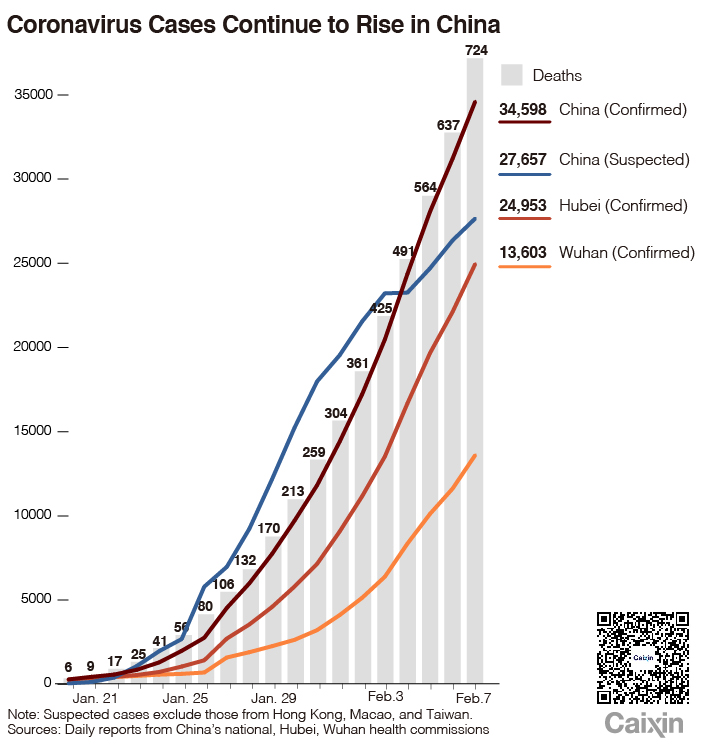Key Diagnostic Test Might Be Missing Many Coronavirus Cases
China’s ability to control a rapidly spreading coronavirus epidemic is under further strain amid fears that a key test used to confirm new cases is failing to catch large numbers of people with the disease.
Problems with so-called nucleic acid tests (NATs) widely used to identify the presence of the previously unknown pneumonia-causing virus make it likely that many infections are going uncounted even as the number of confirmed cases continues to spiral.
Authorities are still struggling to ascertain the true extent of the epidemic, which had infected (link in Chinese) 34,598 people and killed 723 in China as of Friday, according to the National Health Commission (NHC). In Hubei, the province at the epicenter of the outbreak, reports of overwhelmed hospitals, scarce medical supplies, and overly stringent diagnostic criteria have complicated efforts to determine the scope of the disease.
 |
Health officials have recommended cheap, abundant, and generally accurate NATs as one of two main methods to confirm the presence of the coronavirus in humans. The technique involves collecting samples from patients and testing them for specific kinds of molecules that appear in the genetic material of the new coronavirus. If those molecules are present in the sample, the patient is isolated for treatment.
But there is growing concern that those NATs are producing large numbers of false negatives. In a Wednesday interview with state broadcaster CCTV, Wang Chen, an expert in critical diseases and director of the Chinese Academy of Medical Sciences, said one characteristic of the virus was that “not all of those infected by it return positive NATs.”
“Even patients who definitely have the disease only come back positive 30% to 50% of the time,” Wang said. “Testing throat swabs (from potentially infected people) also returns a lot of false negatives.”
But on Feb. 9, She Danyang, a deputy director of the respiratory unit at the General Hospital of the People’s Liberation Army — a major Beijing-based facility charged with treating the country’s military and political elites — said Wang’s words had been misconstrued. What Wang had meant was that 30% to 50% of suspected cases likely test positive for the virus, she said in a conference call.
While NATs were sensitive enough to identify coronavirus infection in up to 90% of cases, problems like the varying viral loads of patients, the degradation of the virus during transportation, and differences in manufacturers’ diagnostic kits were affecting the results of coronavirus diagnoses, she said.
Only a very few infected patients were receiving multiple negative NATs, and doctors were being careful not to rule out coronavirus infection solely on the basis of the tests, she said.
Tests like NATs are especially important in people that may have contracted the virus but have not yet shown symptoms. Emerging trends in local infections mean that many such patients may have been sent home by hospitals after their NATs came back negative, doctors told Caixin.
“At the moment, more and more cases in Wuhan are flaring up collectively in family groups, and the majority are of the concealed onset type,” said Zhang Xiaochun, a deputy director of the medical imaging department at Zhongnan Hospital of Wuhan University, one of the institutions at the center of the outbreak. “They may have undergone one or even several NATs and shown no clinical symptoms, but keeping them under observation at home is bound to spread the disease further.”
A doctor in the imaging department of another major Wuhan hospital, who spoke on condition of anonymity, told Caixin said that previously some patients whose CT scans clearly showed signs of viral infection but whose NATs tested negative were “released” back into their communities due to a shortage of hospital berths.
NATs are by nature an imperfect mechanism for determining the presence of a given organism. For instance, because the genetic material they test for usually only exists in tiny amounts, many NATs include a step called amplification, which makes many copies of it. A shortcoming of amplification is that it also copies any contaminating DNA in the sample, potentially causing misleading results.
“All experienced doctors know that NATs contain flaws,” the doctor told Caixin.
Aside from NATs, health officials have also recommended the use of gene sequencing to confirm coronavirus infections.
But that method has its own problems. Although gene sequencing is comparatively accurate, it is also expensive, and not all affected hospitals have the necessary facilities. Additionally, at the start of the outbreak, many hospitals had to gain permission from higher authorities to conduct such tests, a rule that has since been relaxed.
Experts have previously called for the inclusion of CT scanning as a key basis for diagnosing coronavirus infections, as well as rapid hospital admission and isolation.
In response to calls from medical professionals on the frontlines of the epidemic, the NHC on Tuesday relaxed the clinical criteria for reporting suspected coronavirus cases, with extra leeway granted to people in Hubei.
Outside the stricken province, medical professionals should now suspect coronavirus infection in patients with radiographic evidence of pneumonia, fever and/or breathing problems, and a low-to-normal white blood cell count or a low lymphocyte count. Within Hubei, only two of the three criteria are required.
China added more than 3,000 new coronavirus cases each day from Monday through Friday, with the vast majority occurring in Hubei, according to NHC figures.
This article was re-edited on Feb. 13 to add comments by She Danyang that clarified problems with nucleic acid tests. She made the comments after the story was originally published.
Contact reporter Matthew Walsh (matthewwalsh@caixin.com)

- MOST POPULAR








